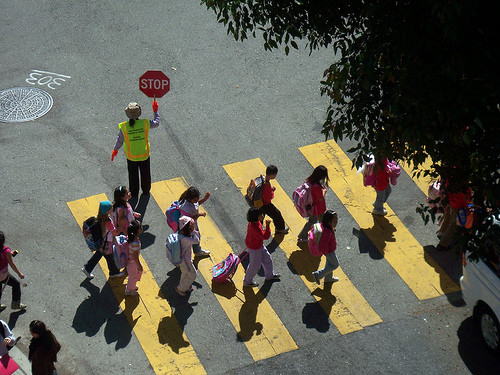How the NYC real estate divide skews friendships: One private school teen’s take
“Your apartment is SO cozy!” my friend squealed over my family's 1200 square-foot apartment. I suppose it probably felt cozy—read: small—compared to her own rather drafty apartment where the foyer was more reminiscent of a dance studio than a hallway.
We were in second grade, by the way. I’d become friends with a girl I met during my first year at a private elementary school on the Upper West Side. This girl, wealthy but average compared to many of my classmates and barely eight years old, quickly picked up on the “coziness” of my apartment compared to her own. In retrospect, I’m shocked not only by her mastery of coded language at that spritely young age, but also by her ingrained sense of real estate superiority.
Then again, real estate is a fixture in the lives of anyone living in New York City. Everything from the neighborhood down to the presence—or lack—of a washer and dryer sends off signals for any and all guests to interpret. Unlike the suburbs, there is no such thing in the city as “rows of cookie-cutter houses” or any kind of economic homogeneity for more than a square mile. Every time you visit someone’s home as a kid, it’s an adventure and a curiosity: Does your friend have her own room? Will it have a bed that's barely fitted to the exact dimensions of the room, or will it have a huge, hide-and-seek-friendly walk-in closet? Will there be a five-floor brownstone to play Hogwarts in, or will you have lunch in front of the TV in the living/dining room?
Now, I've never felt apartment shame nor envy; my own apartment is bright, comfortable, and perfectly sized for a close-knit family of three. (Despite my eight-year-old friend's sizing up, I don't think my apartment is small at all, except perhaps in the brutal world of NYC real estate.) We live in a safe, convenient neighborhood and a good school district. With hardwood floors, bedrooms with walking space, a closet per person, functioning kitchen, I’ve never felt anything but extremely fortunate for our situation.
But while I’ve never yearned for the post-modern, stainless-steel palaces of my wealthier classmates, or for the brownstone Versailles of others, adorned with paintings and French furniture, I notice things. Like it or not, real estate in this city hints at one's means, separating the haves from the have-nots.
In ninth grade, I transferred to another uptown private school and acquired a far more diverse group of friends compared to that which I had at my more homogenous old school. Ranging from the wealthiest one-percenters to NYC middle class to people who receive copious financial aid, my friends all have radically different lifestyles and opportunities. These economic differences shape social awareness, behavior, and grouping from the very first playdate.
Sure, kids make friends based off of humor, friendliness, and shared interests. But friendships also often depend on proximity and shared experiences, both of which are lacking between most of my school’s wealthy and less wealthy students. After all, at a certain point, how can one not notice that someone else lives in a two-story penthouse with a state-of-the-art kitchen the size of a normal living room and a private rooftop? How can one not notice when your friend pulls out what you think is a TV remote and turns out to be the remote they use to get the automated bookshelves to move aside and reveal the TV that lies, James Bond-style, in a secret alcove (something I once actually witnessed with my own two, wide eyes)? How can one not notice that the guy with a brownstone said that his summer house, located on a mansion-lined street in Southampton, was in the “poor part of the Hamptons?”
These are the kids who have huge parties and “frees” while their parents stay at the office late or travel for work, or sleep in the distant top floor bedroom. These are the kids who can always have sleepovers, host dinners for their homeroom get-togethers outside of school, and, ultimately, orient their social groups depending on the availability of their apartment.
And then there are the less wealthy kids, most of whom live in the outer boroughs, Long Island, and New Jersey, who routinely commute more than an hour a day to come to school. Most of the Manhattan kids would never want to commute two-plus hours roundtrip to see them on the weekends. So they not only have a school-commute time, but a social-commute time as well. This “social commute” time creates and destroys friend groups: Many Manhattan parents don’t want their children to travel to the Bronx, and, when the kids are old enough to go where they please, they’ve already made up their minds to stay in or avoid certain neighborhoods. Moreover, after witnessing the bizarrely common spectacles of their classmates' luxury Manhattan dwellings, those with more modestly sized and decorated apartments often don't feel comfortable inviting people over, let alone hosting parties that would probably violate Fire Department regulations.
After we'd both spent time together attending cast parties in houses made of two or three conjoined brownstones, get-togethers on the rooftops of penthouses, and a birthday party in a Tribeca loft, it took three years for one of my close friends to invite me to his slightly smaller Crown Heights apartment. When I asked him in junior year why he had never had me over before, he answered that he expected me to complain about taking the subway an hour into Brooklyn and that, after seeing my apartment and those of our classmates, he felt insecure about inviting wealthier students over.
I felt uncomfortable and ashamed realizing that I never understood that my friends had these insecurities and that they thought, by virtue of my class and white privilege rather than my personality, I might look down upon them or their neighborhoods when I saw where they lived. After all, an eight-year-old girl had belittled my own Upper West Side apartment. Relationships between teenagers are far more complex, riddled with hierarchy, and easily poisoned by insecurity. Condescension from a fellow 17-year-old about one’s home would be far more unpleasant.
Often, private school “middle-” and “lower-class” students—I put these terms in quotes because, relative to America's class spectrum, they are entirely inaccurate—are aghast at the obnoxious ostentatiousness of the wealthy students' apartments, vacations, and VIP concert tickets due to their disdain for the seeming ignorance and entitled attitudes that correlate with these commodities. It's hard, for example, for non-super-wealthy students to participate in conversations about which Hamptons neighborhood has the best nightlife, one's favorite Soul Cycle instructor, or proper skiing apparel.>
In the student lounge, if Wealthy Person A says, “Where are you going on vacation?” and Wealthy Person B responds, “Cancún!” Wealthy Person A might say, “I love Cancún! My dad’s friend has a house there…” The non-one-percenters will listen silently, get bored, and start their own conversations when it becomes clear that Wealthy Person A and B will not tire of discussing their trips to Cancún
Later, however, when A and B are gone, you’ll hear the non-wealthy kids’ mockery. In high-class British accents they claim, “My father flies me to Cancún on a helicopter!” “Well, my father redirects the Navy to Cancún and turns it into a top cruise line!” “Well, my father hires fighter jets to take us to Cancún!” Somewhat bitter hilarity ensues.
So, yes, there is tension, but not necessarily jealousy of, or resentment for, the rich; though there might be jealousy for some, most of the time, that couldn’t be further from the truth. It’s easy to reject class hierarchy by making fun of the Hamptons and Juice Generation and making them “uncool,” so that's how less wealthy students cope with the reality that these kids will always have more than they do.
As a result of the wealthy students' class privilege and the less wealthy students' reaction to it, authentic friendships between the two groups are few and far between. Everyone coexists and is completely friendly to one another, but the sad truth is that the hobbies, interests, and activities many students engage in depend on their opportunities and concerns, which precludes the spontaneous formation of friendship between those who have certain opportunities due to their wealth and those who have certain concerns due to their lack thereof.
When a wealthy student expresses no interest in—or a certain derision toward—going to a friend's house in Queens, or goes on and on about Aspen when most students at the table have never been there, it's obvious that real estate as a commodity will always function as a stamp of wealth and resources in this city. And, as a teenager, during a time when many struggle to find others with whom they identify, such "stamps of wealth" deeply complicate our social relationships—as soon as we know the address.
You Might Also Like





























